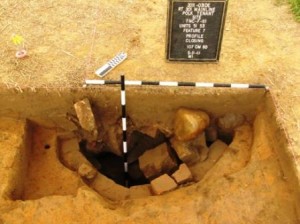

Facebook Twitter Flickr YouTube RSS Feed
Written on: July 1st, 2013 in Archaeology Updates, US301
Here is the location of the Polk Tenant Site on the 1868 Beers Atlas Map.

And a photograph of a partially excavated well at the Polk Tenant Site.

Written on: July 1st, 2013 in Archaeology Updates, US301
Update on the Dale African American archaeological site:
Samuel Dale’s Strange “Manumission,” 1854
The Samuel Dale who owned the Dale Site lived as a free man for most of his life. Born in 1791, he first appeared in the census as a free man in 1810. He was counted as a free man every ten years thereafter, all the way to 1870, shortly before his death. We were therefore shocked to find in the New Castle County deed book for 1854 an entry reading,
Know all men by these presents that I Nicholas Patterson of the City of Wilmington New Castle County and State of Delaware (Minister of the Gospel) from motives of benevolence and humanity, have manumitted and do manumit and set free from slavery my negro man Samuel Dale of St. Georges Hundred in the County and State aforesaid aged about forty years, he the said Samuel Dale having been the slave of James Haughey late of St. Georges Hundred decd who by his will gave the said Samuel Dale (among other things) to his children and the survivor of them, the only survivor of whom is Mrs. Eliza Patterson, formerly Eliza Haughey and now wife of the said Nicholas Patterson.
At first we thought that this must be some other Samuel Dale. After all, this document says Dale was about forty, and the owner of the Dale Site would have been about 65. So far as we can tell, though, the only other Samuel Dale living in St. Georges Hundred was the son of our Samuel Dale, who was younger than forty in 1854 and just as free as his father. We also know that our Samuel Dale was connected to the Haughey family, and that the land Dale bought once belonged to the Haugheys. Besides, until recently many older people had only a vague notion of their own ages. So the manumission must have been for the owner of the Dale Site.
But why was a manumission enrolled in 1854 for a 65-year-old man who had been living free for at least 44 years? Probably because of the other major event in Dale’s life that year, his purchase of the 20 acres of land that became his farm. Either when he proposed to buy the land, or when he tried to have the deed enrolled at the court house, somebody must have demanded proof that Dale was in fact a free man. If there ever was a written record of Dale’s manumission 44 years before, it had been lost. So Dale had to track down the only surviving daughter of his former master and persuade her husband to free him again, this time with proper documentation. Just one small sign of the difficulties faced by African Americans in the nineteenth century.
